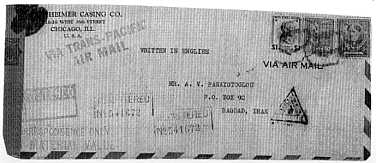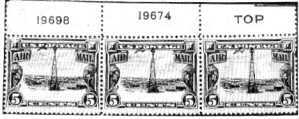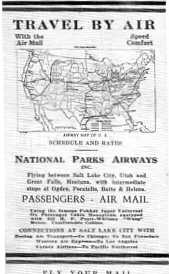

The AirmailCollectingGuide provided in these pages is also available downloadable.
![]()
James W. Graue
One could make a winning case for aviation as the greatest achievement of the 20th century. With flight came the instant realization that with it went communications. Freed from the inherent constraints of all modes of surface travel, communications transported by air- airmail – provided a quantum leap in the advance of mail delivery, and with it the pace of all facets of human life.
Airmail is the philatelic and postal historical reflection of the development of aviation and its effect on world communications. Consider the development of aviation itself and one can find it reflected in the mail that was flown:
The path the limited flights of the pioneers, with special demonstration flights sanctioned to carry souvenir “airmail,” whose successes inspired the development of aircraft in all forms, becoming increasingly fast, range-capable, and reliable, thereby making possible the air carriers, from regional to national, international, intercontinental, and transoceanic; and at every step, from the hesitant first to the confident final, there was – airmail!
Airmail, the actual flown documents, is the foundation of aerophilately. It was not always the standard that it is today, but a premium service requiring the payment of special postage rates, often reflected in the airmail stamps that have been issued world-wide since early in the game. Special airmail markings applied to the airmail, the transit times reflected in dispatch and arrival postmarks, and the airmail postage rates all indicate the means of flight and the route taken. The world for the airmail collector is as wide and deep as one wishes to make it. The choice is unlimited. Consider . . .
The world of airmail, all of which is a product of less than one century, offers the collector almost limitless choice. Much of it is yet untapped, still waiting to challenge the initiative and creativity of an airmail collector – an aerophilatelist!
For further insights into this fascinating world of philately, read on.

Taking off with the mail in Washington, D.C. on May 15, 1918. (National Postal Museum, Smithsonian Institution)
![]()
Jonathan L. Johnson, Jr.
Cover collecting is a wide open field and an extension of stamp collecting. A “cover” is an envelope that has seen postal service. Many have “cachets,” a rubber stamped or printed impression or label placed on the cover descriptive of the event for which it was mailed. Collecting airmail covers can be as inexpensive as the price of postage to service pictorial cancellations or as expensive as the purchase price of a famous rarity, such as a piece of surviving Hindenburg crash mail. Start with a limited objective, pick a category, and collect. You may change your direction along the way or discover new airmail areas of interest.
Routes, rates, cities, states, countries, first days, special events, pilot autographs, and markings are all desirable areas of cover collecting. Some covers may be flown, while others may note a special event, such as an airport dedication. Covers for your collection may be found in dealer stocks at stamp exhibitions and bourses, by mail from established dealers, in club and public philatelic auctions, in exchange with other collectors, and through ads in the philatelic press. Joining the American Air Mail Society is a way to obtain information on these sources.
Postal history or commercial airmail cover collecting is an enjoyable aspect of the hobby. Here you can learn routes, rates, and how airlines developed. The American Air Mail Catalogue provides resource information as well as potential areas of interest. The many AAMS publications, chapters, and study groups are all ready to help you and receive your input as you study stamps and markings on airmail covers.

Cover posted July 7, 1941, Chicago, flown to San Francisco, placed on board one of the Pan American Airways flying boats, and flown to Singapore on FAM Route 14. It then was flown to Baghdad, Iraq by either a British or Dutch airline, arriving on August 6. It was censored in India, bearing both a censor handstamp and censor tape sealed with wax. Franked at $1.55 for twice the rate of 70¢ per 1/2 ounce + 15¢ registry fee.
![]()
Kent J. Kobersteen
Airmail stamps can provide a fascinating, aesthetically pleasing, historically informative topic for the collector. You can build a collection of airmail stamps which is as broad as a single copy of every airmail stamp which has been issued worldwide, or as narrow as a specialized look at a single series or a single issue. Airmail postcards, stationery, and aerogrammes provide yet another area of specialization.
A collection of worldwide airmail stamps will show not only the development of aircraft and air-related events, but also will show how the airmail service developed worldwide. So too, will the collection of a single country’s airmail issues tell the story of the development of airmail in that country. In the case of the United States, for instance, the development of the airmail both domestically and internationally, and the rates for this service, can be traced through a collection of U.S. airmail stamps.
You can also specialize in a single series, such as the U.S. Transport issue of the early 1940s, or a single stamp such as the Beacon airmail stamp of 1928. At first glance you might assume such specialization would limit your collecting options. Quite the contrary. After avidly collecting the Beacon airmail stamp for over fifteen years, one continually finds new material in usages on covers and in an extensive representation of the stamps.
A first step in building such a specialized collection of a single issue or series is to consult catalogues and specialized literature. The American Air Mail Catalogue, Scott’s Specialized U.S. Stamp Catalogue, and Max G. Johl’s The United States Postage Stamps of the Twentieth Century, Volume III, will indicate plate positions, recuts, varieties, and errors which have been found by other specialists. Many aerophilatelists have published works based on their research; a search of the philatelic literature will reveal new information in a variety of areas. It is extremely gratifying to make a discovery that has been overlooked by earlier experts.
You might begin with the design itself, researching its origins. Essays of some stamps may be on the market, others exist only in the archives of the Bureau of Engraving and Printing in Washington, D.C.
Mint stamps can be obtained showing various plate positions, guide lines, plate numbers, and other marginal markings, as well as sideographer and plate finisher’s initials – – if they occur on the issue being studied.
It is also important to learn about the appropriate printing and perforating processes to analyze production varieties of the stamp or stamps in question. As you look at more copies of the stamp, you will find slight variations due to production differences. The archives of the Bureau of Engraving and Printing contain a wealth of information about the production of United States issues.
Used copies of airmail stamps offer unusual and interesting cancellations with numerous possibilities: fancy cancels, slogan cancels, socked-on-the-nose cancels, numeral cancels, paquebot and foreign cancels — the list is nearly endless. You can also search for stamps with perforated insignia or perfins and precancels. Many pleasant hours can be had pouring over dealers’ stocks or large lots of relatively common stamps. And, when mounted, the display of various cancellation varieties can be impressive.
Once you feel you have exhausted the possibilities of your stamp study, keep looking, and examine other stamp exhibits for ideas of new directions to pursue. You can always find more fascinating material to add to your stamp collection, and through study and scholarship you can contribute to the overall body of knowledge of your specialty.

Inaccurate registration of vignette and frame printings created this example of a dramatic shift on the Beacon airmail stamp.
![]()
Basil S. Burrell
In addition to postage stamps on flown mail, you may discover other adhesives on cards or envelopes. Some collectors find this an intriguing specialty study area, as they seek mail with various etiquettes, air labels, and semi-official airmail stamps.
Etiquettes are government issued labels which are designed to be adhered to letters which shall be carried via airmail. Countries and post offices all around the world have issued these labels, as listed in Jones’ Etiquettes: Par Avion – By Airmail.
The original intent was to speed up the means of transport, over long or arduous routes. When the United States Government decided to fly all mail, if it deemed it to be more convenient and economical, the use of etiquettes became unnecessary except for international mail.
Air labels are labels, similar to etiquettes, that the air lines issue and give away to advertise their air line name and identify airmail letters.
When all mail went via air “when convenient,” the air lines decided these labels were an unnecessary expense, especially since the post office offered complimentary etiquettes. Therefore, most U.S. airline air labels are pre-1955.
The Aeronautica and Air Label Collectors Club, an AAMS chapter, has published the eight-volume Airtransport Label Catalog. Earlier works such as Muller’s Catalogue des Etiquettes Aeropostales and Field’s Aero Field Handbook of Airmail Labels would also provide resource information.
You can also find labels with an aviation theme issued privately and by various organizations for air shows, airport dedications, stamp shows, rocket mails, local posts, advertising, and other special events.
Semi-official airmail adhesives are government approved, but privately issued, stamps sold at post offices and designed to pay for the cost of air transport of mail. These letters, or covers, were required to have the regular surface government stamps to cover the cost of delivery. The private air lines then, with the pilot acting as a postman, carried the sacks of mail from post office to post office.
An example of this arrangement took place in Canada where long distances north of Winnipeg or Edmonton could be reached in a day by plane, while it might take two weeks by dog sled. There were 16 such companies that operated in Canada from 1924 to 1934.

United Air Lines promoted their service and identified airmail letters with this complimentary air label.
![]()
Dan Barber
For nearly seventy-five years airmail stamps and covers have appeared in more magazines, journals, monographs, and catalogues than most other philatelic specialties. Far beyond the usual listings of how many stamps were issued or how many covers were flown, a long succession of aerophilatelic scholars have pored over newspaper clippings, postal archives, airline timetables, aircraft registries, pilot biographies, and mountains of aeronautic and aviation publications.
Even before World War I the Aero Mail Club – the world’s first aerophilatelic organization – began a serialized reporting of United States pioneer flight covers in Percy McGaw Mann’s Philadelphia Stamp News, and later in The New England Philatelist. However, it was not until 1923 that England’s Aero Philatelic Club of London and the Aero Philatelic Society of America began to issue monthly mimeographed sheets to its first members.
Throughout the 1920s and 1930s a series of sometimes short-lived airmail groups added to the offerings with occasional magazines. But airmail journals and catalogues gained new visibility as the American Air Mail Society (AAMS) began its own publication series after 1931.
In 1926 Francis J. Field in England initiated a house organ, The Aero Field, that for nearly sixty years would cover an international scene of airmail stamps and covers, while several years later in the United States the AAMS rapidly increased its circulation of The Airpost Journal, which became its monthly magazine.
As aviation, airmail, and aerophilately developed, collectors cast about for every bit of paper about planes, pilots, stamps, and covers. An article about the latest exploit of Charles Lindbergh or Amelia Earhart became as intrinsic to aerophilately as the latest auction catalogue of Fred Kessler, Irwin Heiman, or Nicolas Sanabria.
Zeppelin brochures and airline timetables became as necessary as The Postal Bulletin. Every article about the most recent Boeing or Douglas aircraft was a fundamental reference; some aerophilatelists snapped up the rotogravure sections of newspapers or stopped in the local movie house for clips of the latest long-distance flight.
Aerophilately has long been a hobby devoted to a mass of literature about much more than stamps and covers. There are literature hounds who go after long runs of aviation magazines of the 1920s and 1930s, as well as scholars who study auction catalogues of a number of firms. And every time there is a new biography released on some early airmail pilot, an aerophilatelist somewhere will be searching for a copy. With the aerophilatelist the book store becomes nearly as important as the stamp show.
The usual stamp catalogues and airmail cover handbooks have been around – and will continue to appear – for many decades, but the dedicated aerophilatelist is much like an archaeologist, digging about for more information about airlines, pilots, planes, flights, and a host of other details that define a hobby with few boundaries.
The literature of aerophilately is sometimes more difficult to locate than the airmail stamps and covers that collectors continue to study. A set of the three 1930 United States Zeppelin stamps can be easily found and purchased, but only the devout airmail specialist will keep searching for that elusive aircraft book or aeronautic magazine with the definitive article.
Since 1940 the American Air Mail Society has been one of aerophilately’s most committed, and most successful, publishers, continuing a long tradition of journals, catalogues, and handbooks for specialized study. The future is still bright for aerophilatelic literature – there are still many airmail stories to be told. And collectors will forever seek the multitude of books and magazines that define a hobby quite undefinable.

Timetables, such as this example from National Parks Airways, can be a great source of information on routes, schedules, and airmail rates.